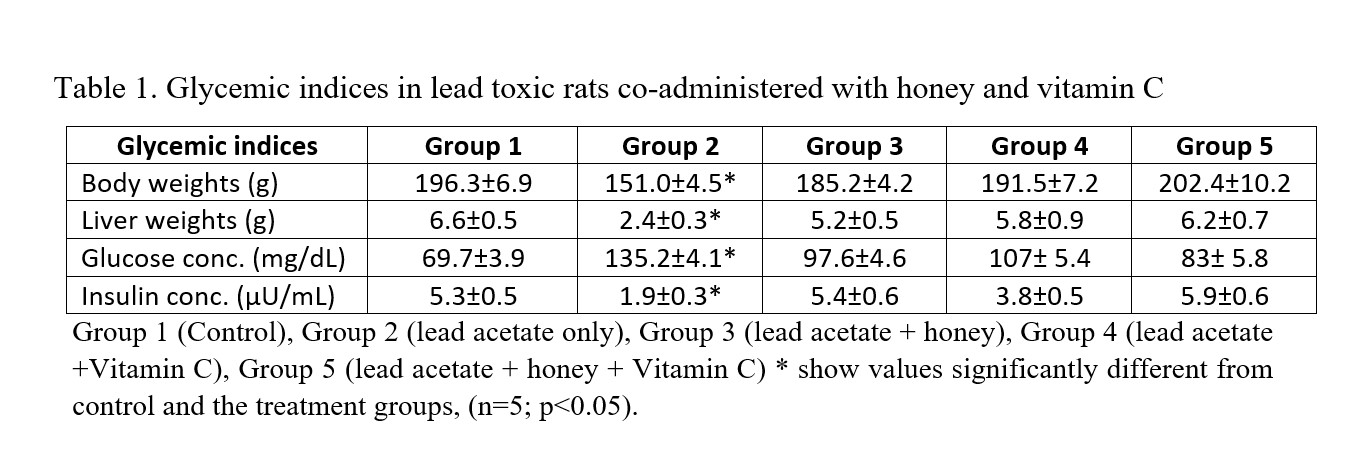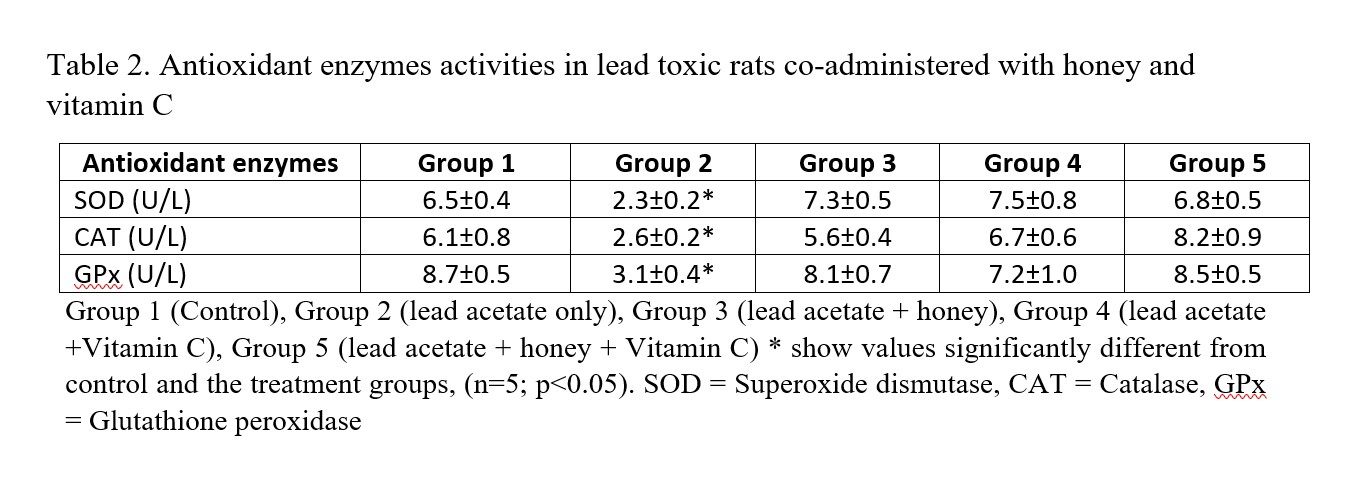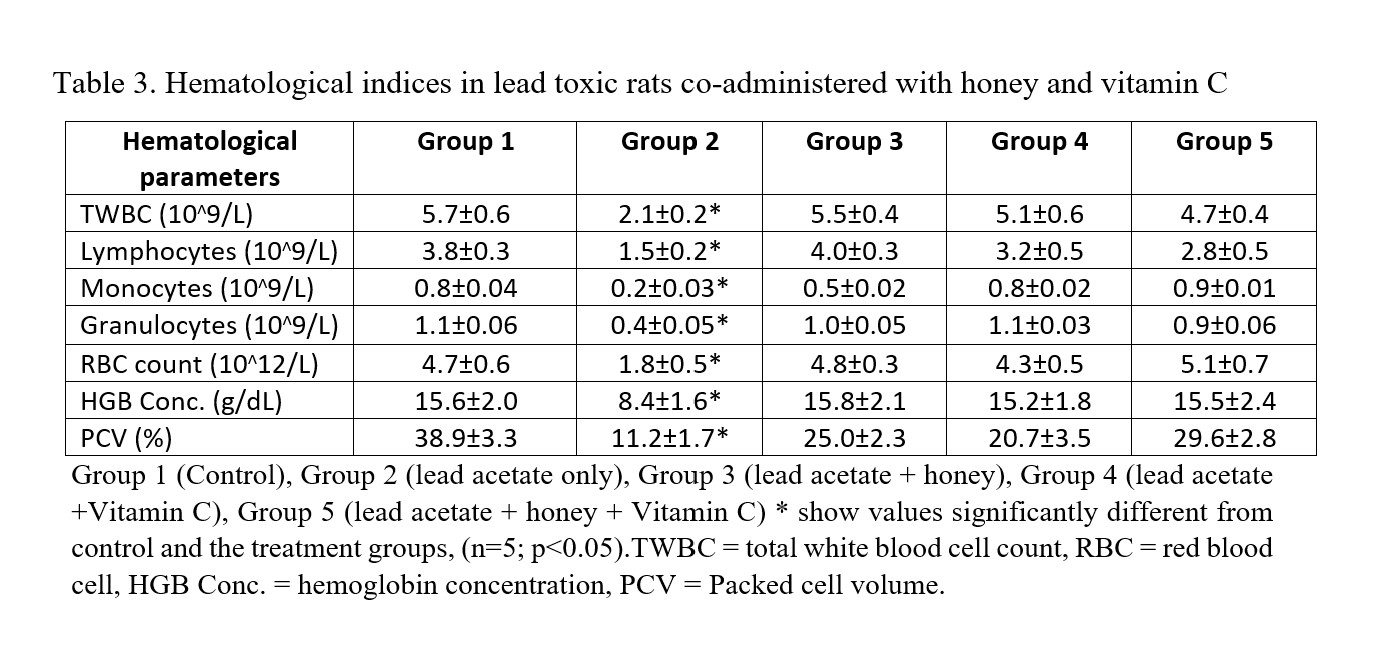Introduction: Lead is an environmental toxicant known to cause glucose intolerance and hematological disorders through oxidative stress damage. Studies have reported the antioxidative potential of honey. However, the mechanisms of its antioxidative activity have not been fully elucidated. Aim: This study was designed to investigate the effects of honey on glycemic and hematological indices in lead induced toxicity using male Wistar rats. Methods: Twenty-five (25) Wistar rats were randomly divided into five (5) groups (n=5) as follow; group 1 served as control which received deionized water, group 2 served as lead acetate group (40 mg/kg), groups 3, 4 and 5 served as lead acetate groups co-administered with honey (1 ml/kg), vitamin C (100 mg/kg) and honey+vitamin C (1 ml+100 mg/kg) respectively. The treatments were orally administered for 28 days. The rats were anesthetized using ketamine (100 mg/kg) and xylazine (10 mg/kg) intraperitoneally, blood and organ samples were collected and thereafter the rats were euthanized through cervical dislocation (Alemán-Laporte et al., 2020; AVMA, 2020). Body and liver weights, blood glucose and insulin concentration were determined using analytical weighing balance, glucose oxidase and ELISA methods respectively. Superoxide dismutase (SOD), Catalase (CAT) and Glutathione peroxidase (GPx) were determined using spectrophotometry procedure. Hematological indices were measured using auto-analyzer. The pancreas histology were assessed using hematoxylin and eosin staining technique. Data were analyzed using ANOVA and results expressed as mean ± S.E.M., at p<0.05. Results: A significant increase was observed in body weight, liver weight, insulin concentration, SOD, CAT, GPx, TWBC, lymphocytes, monocytes, granulocytes, RBC count, HGB concentration and PCV in lead acetate groups co-administered with honey, vitamin C and both when compared to lead acetate only (Tables 1, 2&3) . However, fasting blood glucose decreased significantly in lead acetate groups co-administered with honey, vitamin C and both compared to lead acetate only (Table 1). Histological evaluation of the pancreas showed areas of necrotic lesions in lead acetate only compared to lead acetate groups co-administered with honey, vitamin C and both. Conclusion: Honey exhibits its antioxidative potentials by increasing the activities of antioxidant enzymes, improving glycemic control and maintaining hematological profile in Wistar rats. Keywords: Lead, Honey, Glycemic indices, Hematological indices, toxicity. Ethical Standards: The study was approved by the Institution Review Board of the University of Medical Sciences, Ondo City, Nigeria and conducted according to the guidelines for the use of animal by the National Institute of Health.
Future Physiology 2021 (Virutal) (2021) Proc Physiol Soc 47, PC24
Poster Communications: Effects of honey on glycemic and hematological indices in lead-induced toxicity in male Wistar rats
ADEYOMOYE OLORUNSOLA ISRAEL1, Adesida Adedayo1, Akintayo Christopher2, Adewumi Nifemi1
1 Department of Physiology, Faculty of Basic Medical Sciences, University of Medical Sciences, Ondo City, Nigeria. , Ondo, Nigeria 2 Department of Physiology, College of Medicine and Health Sciences, Afe Babalola University Ado-Ekiti, Ekiti State, Nigeria., Ekiti, Nigeria
View other abstracts by:
Where applicable, experiments conform with Society ethical requirements.



